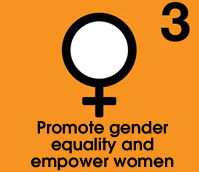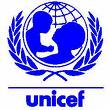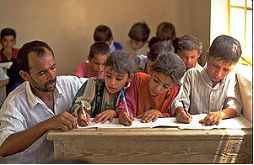| |
Notre Dame Virtual School
PROMOTE GENDER EQUALITY AND EMPOWER WOMEN
INTRODUCTION
Poverty has a woman's face. Global prosperity and peace will only be achieved once all the world's people are empowered to order their own lives and provide for themselves and their families. Societies where women are more equal stand a much greater chance of achieving the Millennium Goals by 2015. Every single goal is directly related to women rights, and societies where women are not afforded equal rights can never achieve development in a sustainable manner. In Asia, Latin America, and Africa, where women have been given the chance to succeed through small business loans or increased educational opportunities, families are stronger, economies are stronger, and societies are flourishing.
(Adapted from: UNICEF)
WEBSITES (Excerpts from the websites appear below)
Because I am a Girl: The State of the World's Girls 2008
Special Focus: In the Shadow of War
This 185-page report is published by Plan International for the purpose of bringing global attention to the fact that progress towards meeting the Millennium Development Goals (MDGs) is being hampered by a continued lack of investment in girls and young women. The report begins with the premise that the condition and position of girls' lives matters, and that the impact of conflict on girls is far-reaching and goes beyond their experiences as either combatants or victims of violence. It intends to show how conflict affects girls differently from boys and how their rights are ignored, their responsibilities changed, and their lives altered by war. It describes how discrimination against girls is in place before the fighting begins and remains after it is over. The report also examines the implications of
conflict for girls' health, girls' education, gender roles, and relationship dynamics.
UNICEF is committed to changing the world for children. It strives to protect their rights, improve their health, and nurture their development through sound planning and monitoring of policy results. This UNICEF site provides a great deal of data and statistical information about the situation of women and children around the world.
When a country educates its girls, its mortality rates usually fall, fertility rates decline, and the health and education prospects of the next general improve.
What will it take to improve girls' enrollments? Mainly, overcoming the social and economic obstacles that stop parents from sending their daughters to school. For many poor families the economic value of girls work at home exceeds the perceived returns to schooling. Improving the accessibility of schools and their quality and affordability is a first step.
PROJECTS
www.teachunicef.org TeachUNICEF
TeachUNICEF helps teachers engage students as active global citizens in learning about UNICEF — the United Nations Children's Fund — and its efforts on behalf of children worldwide
What is TeachUNICEF?
© UNICEF/ HQ99-0623/ Pirozzi
IRAQ: A teacher helps students, sitting three to a desk, with their lesson in a classroom at Al-Mustafa Primary School in the village of Al-Zuraiji, near the southern port city of Basra. The school, like many in the area, has been rehabilitated by the community with assistance from UNICEF.
TeachUNICEF launched in 2005 as a resource for educators of school children throughout the United States. It is recognized that U.S. educators need effective tools to help their students develop the skills needed to survive and thrive in a world of dynamic change. This domestic education program is designed to help educators bring a global understanding of the needs of children and families around the world into the classroom.
Based on UNICEF's annual flagship publication, the State of the World's Children (SOWC), the U.S. Fund for UNICEF has developed lesson plans for educators to use with students in grades 6-12.There is a middle school and a high school version of each lesson plan.
The internationally agreed framework of 8 goals and 18 targets was complemented by 48 technical indicators to measure progress towards the Millennium Development Goals. Each indicator is linked to millennium data series as well as to background series related to the target in question. Students can monitor the progress of the goals on this site.
READINGS
In poor households in developing countries, many families will send only one boy children to school, because it is accepted for a girl to stay home to care for younger siblings and the household. This reality brings us to the lone target for Goal 3-that equal numbers of girls and boys should be enrolled in primary and secondary school as soon as possible. And, by 2015 equal number of boys and girls should be enrolled in higher education.
Gender equality & women's empowerment: Role of volunteers
The high priority accorded to Goal 3 of the Millennium Development Goals (MDGs) “Promote gender equality and empowerment of women” – is an affirmation of the international support for women’s rights and gender equality as core values of development. Through the years, women have progressed in many areas: we now have women presidents, prime ministers, Nobel Prize winners, parliamentarians, community leaders and ever increasing number of women volunteers. But serious challenges persist -- cultural attitudes that debase women, gender violence, laws that favour men, and limited access to health care, to name a few.
~
On the occasion of the International Women’s Day (8 March), we bring you a compilation of resources about the role of women volunteers in empowering other women and the challenges they face in promoting gender equality and volunteering.
MDG 3: Promote gender equality and empower women
06 October 2008
Volunteerism and FGM in Sudan~by Dr. Nafisa Mohamed A. Bedri
Alexandria, Egypt: In 2006, the United Nations Volunteers (UNV) programme, along with the United Nations Population Fund (UNFPA) and Ahfad University for Women in Sudan implemented an innovative program to encourage volunteerism and to mobilize local communities to combat female genital mutilation (FGM) in Sudan. The project aimed to combat FGM by drawing on volunteerism and local community action.~ It has attempted to utilize a combination of new and existing approaches to bring about change in its target area, Abu Saeed in Omdurman, Sudan.
SND EDUCATION PROJECT
The Sisters of Notre Dame from across the congregation have constructed a prayer-study-action program. Each section includes references to sources, websites, and further information about the goal and what others around the world are doing to reach it.
The pdf file on MDG #3 can be found in this Unit.
RESOURCES
This resource uses posters and activities to introduce children to the MDGs. Each poster covers a theme and a goal, with a vibrant image for display and discussion. Each poster also includes background information, case studies, and lesson plans.
Themes such as reducing poverty, educating children, fighting disease, and cleaning up the environment are all covered.
| |||||||








